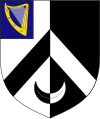
Back هارولد ألكسندر Arabic هارولد الكسندر ARZ Harold Aleksandr Azerbaijani Харолд Александър Bulgarian Harold Alexander Catalan Harold Alexander Czech Harold Alexander Danish Harold Alexander, 1. Earl Alexander of Tunis German Χάρολντ Αλεξάντερ Greek Harold Alexander Esperanto
The Earl Alexander of Tunis | |
|---|---|
 Alexander in late 1944 | |
| 17th Governor General of Canada | |
| In office 12 April 1946 – 28 January 1952 | |
| Monarch | George VI |
| Prime Minister | |
| Preceded by | The Earl of Athlone |
| Succeeded by | Vincent Massey |
| Minister of Defence | |
| In office 1 March 1952 – 18 October 1954 | |
| Prime Minister | Winston Churchill |
| Preceded by | Winston Churchill |
| Succeeded by | Harold Macmillan |
| Lord Lieutenant of the County of London | |
| In office 25 April 1957 – 1 April 1965 | |
| Monarch | Elizabeth II |
| Preceded by | Alan Brooke |
| Succeeded by | Himself (as Lord-Lieutenant of Greater London) |
| Lord-Lieutenant of Greater London | |
| In office 1 April 1965 – 28 December 1966 | |
| Monarch | Elizabeth II |
| Preceded by | Himself (as Lord Lieutenant of the County of London) |
| Succeeded by | Gerald Templer |
| Member of the House of Lords Lord Temporal | |
| In office 1 March 1946 – 16 June 1969 Hereditary Peerage | |
| Preceded by | Peerage established |
| Succeeded by | 2nd Earl Alexander of Tunis |
| Personal details | |
| Born | Harold Rupert Leofric George Alexander 10 December 1891 London, England |
| Died | 16 June 1969 (aged 77) Slough, Buckinghamshire, England |
| Spouse | |
| Children |
|
| Alma mater | |
| Profession | Soldier |
| Signature |  |
| Nicknames |
|
| Military service | |
| Allegiance | United Kingdom |
| Branch/service | British Army |
| Years of service | 1910–1946[2] |
| Rank | Field Marshal |
| Unit | Irish Guards |
| Commands | |
| Battles/wars | |
| Awards | See below |
| Service No. | 17884 |
| |
|---|---|
| Earl Alexander of Tunis | |
 Arms of Earl Alexander of Tunis | |
| Tenure | 14 March 1952 – 16 June 1969 |
| Successor | Shane Alexander, 2nd Earl |
| Other titles |
|
| Parents |
|
Harold Rupert Leofric George Alexander, 1st Earl Alexander of Tunis KG, GCB, OM, GCMG, CSI, DSO, MC, CD, PC (Can), PC, (10 December 1891 – 16 June 1969)[3] was a senior and highly decorated British Army officer who served in both of the world wars. In addition, following the end of his military career, he served as Governor General of Canada and became the first Lord Lieutenant of Greater London in 1965.
Alexander was born in London and was educated at Harrow before moving on to the Royal Military College, Sandhurst, for training as an army officer of the Irish Guards. He rose to prominence through his service in the First World War, and continued his military career through various British campaigns across Europe and Asia during the interwar period. In the Second World War, Alexander, initially in command of a division, oversaw the final stages of the Allied evacuation from Dunkirk and subsequently held field commands in Britain, Burma, North Africa and Italy, including serving as Commander-in-Chief Middle East and commanding the 18th Army Group in Tunisia. He then commanded the 15th Army Group for the capture of Sicily and again in Italy before being promoted to field marshal and being made Supreme Allied Commander Mediterranean in late 1944.
In 1946 he was appointed as Governor General of Canada by King George VI, on the recommendation of the Prime Minister of Canada, William Lyon Mackenzie King, to replace the Earl of Athlone as viceroy, and he occupied the post until he was succeeded by Vincent Massey in 1952. Alexander proved to be enthusiastic about the Canadian wilderness and popular with Canadians. He was the last Governor General who was born in the United Kingdom as well as the last Governor General to be a peer.
After the end of his viceregal tenure, Alexander was sworn into the Queen's Privy Council for Canada and thereafter,[4] in order to serve as the British Minister of Defence in the Cabinet of Winston Churchill, into the Imperial Privy Council. Alexander retired in 1954 and died in 1969.
- ^ "Earl Alexander's Funeral (1969)". Youtube. British Pathé. 13 April 2014. Retrieved 30 March 2024.
- ^ "British Army officer histories". Unit Histories. Archived from the original on 9 July 2022. Retrieved 13 May 2022.
- ^ Hunt, David. "Alexander, Harold Rupert Leofric George, first Earl Alexander of Tunis". Oxford Dictionary of National Biography (online ed.). Oxford University Press. doi:10.1093/ref:odnb/30371. (Subscription or UK public library membership required.)
- ^ Privy Council Office (30 October 2008). "Historical Alphabetical List since 1867 of Members of the Queen's Privy Council for Canada". Queen's Printer for Canada. Archived from the original on 17 January 2012. Retrieved 20 March 2009.
© MMXXIII Rich X Search. We shall prevail. All rights reserved. Rich X Search